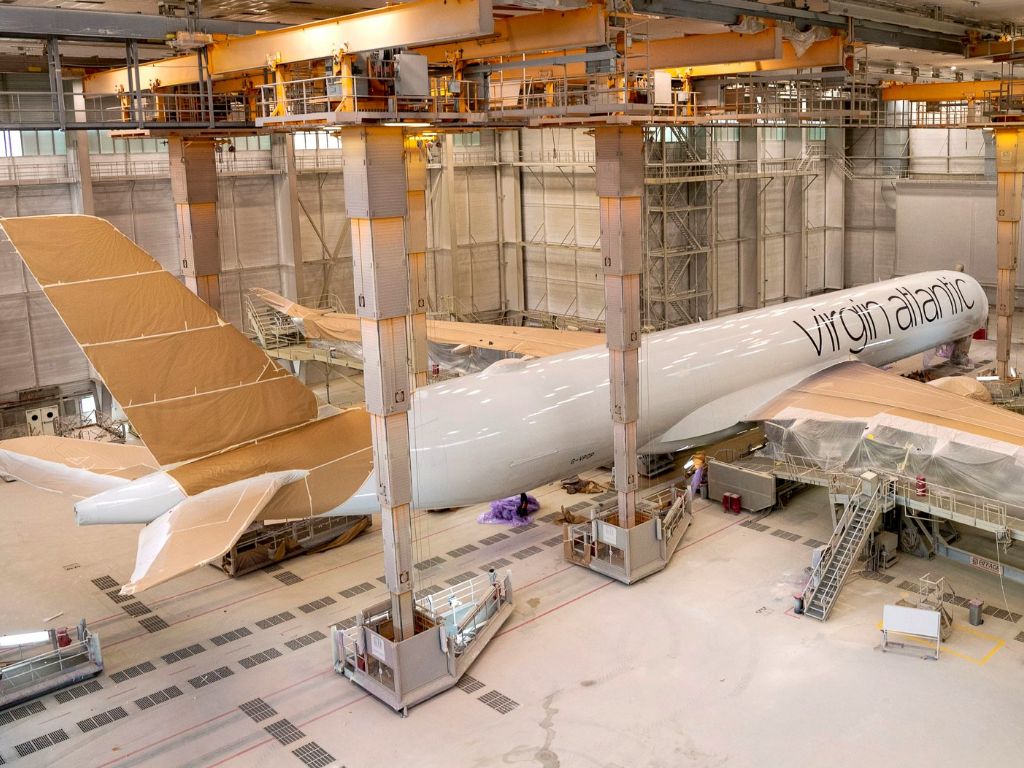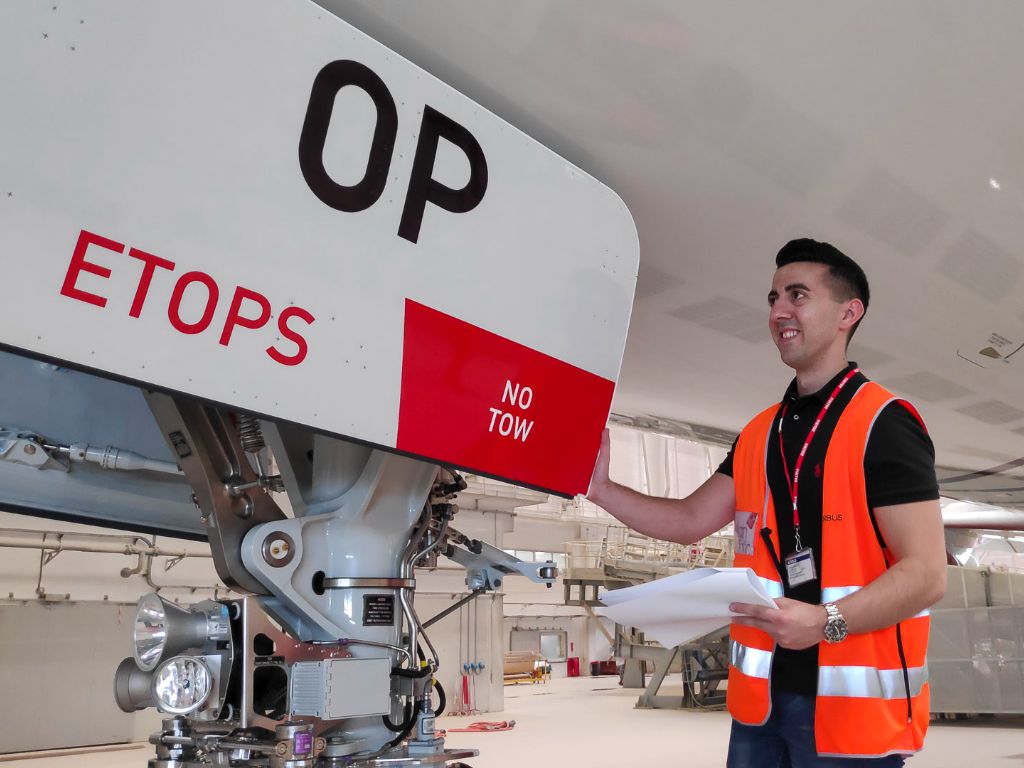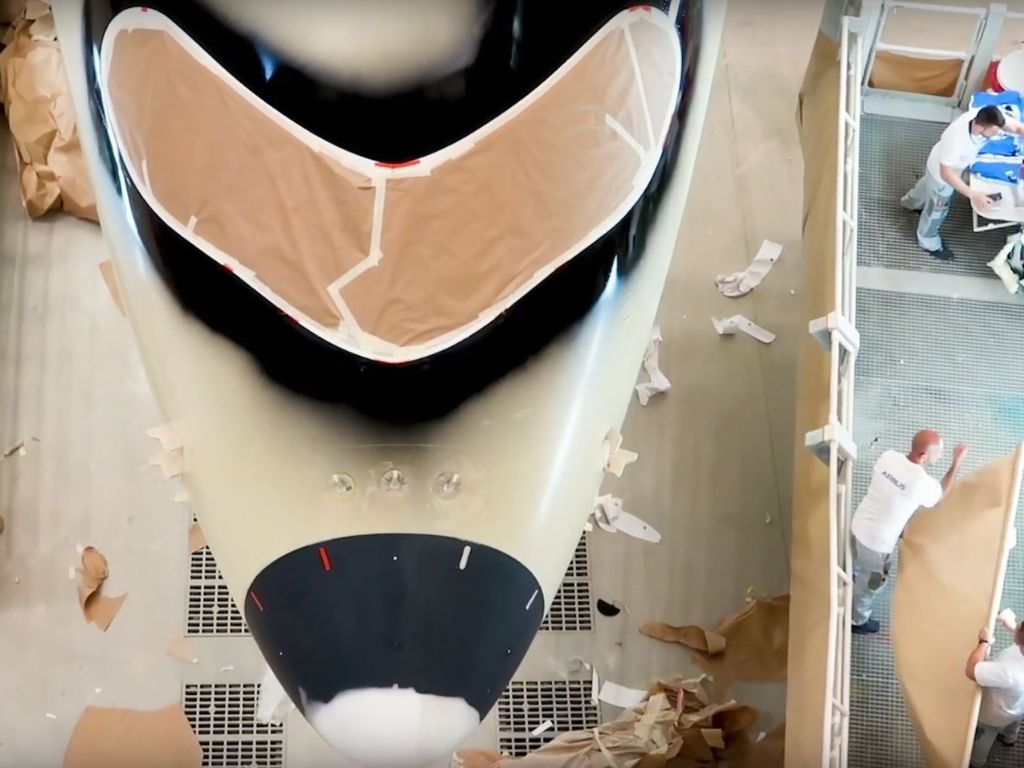Photo: Airbus
It's always a satisfying moment to see a brand new aircraft type freshly painted in our livery for the first time. That happened today when G-VPOP, the first of our Airbus A350 fleet, rolled out of the paint shop at the Airbus factory in Toulouse.
G-VPOP, or Mamma Mia, had entered Hangar C33, 20 days ago with a patchwork of green, beige and white primers covering its primarily composite material fuselage, and emerged in our iconic red and silver colour scheme.
There’s an awful lot of science involved in painting an aircraft. The paint must be hard wearing but also flexible to cope with the loads on the aircraft structure. It needs to withstand huge swings in temperature, from minus 55 degrees Celsius at cruise altitude to 40 degrees on the ground in hot climates. It also protects the aircraft structure from harsh UV light in the upper atmosphere. And, of course, the livery is the most visible representation of our brand, so it needs to look amazing.

It costs a considerable amount of money to paint an aircraft, so the pressure is on to get it exactly right. And being Virgin Atlantic, we’ll add to that pressure by insisting on using some of the most technically challenging paint to apply. Overseeing the whole paint process is camera-shy senior design engineer Dave Napper, and design and development engineer Sam Hamdan. They work with Paul Reilly, one of our aircraft assets managers responsible for the delivery of our A350 fleet. I caught up with them to discover more about the process and soon felt like I was in the middle of a particularly intense but fascinating science lesson. Here’s what I learned:
Before the aircraft went in to be painted, both our design team and the A350 project team had been working for months with the Airbus Livery Design Office. The process involves 3D modelling to make sure the livery meets all safety requirements and regulations, and that everything lines up perfectly.
When the aircraft enters the paint hangar, it is prepped for painting and then it will take about 20 Airbus specialists around eight days to apply the paint. Only certain areas can be customised: the fuselage, winglets, tailfin (or vertical stabiliser) and engine nacelles. The remaining areas (including the “Mask of Zorro”) are standardised across all airlines.
The material used to mask the paint isn’t plain paper. It’s a very specialised plastic that allows the solvents to evaporate but doesn’t allow the paint to pass through it.
What makes our aircraft really stand out is the use of an extraordinary paint called Andaro, which is applied in red onto our wingtips, engine covers and vertical tail plane, and in aubergine for the letters of our logo. This highly reflective paint is unique to us in the airline world, and it looks absolutely gorgeous, especially in the sun.

Just a couple of the hundreds of decals. Sam Hamdan performs the final inspection before accepting the paint job on G-VPOP..
As the old saying goes, ‘If it were easy, everyone would do it’. Andaro paint takes some serious skill to get right, which is why the team at the Airbus Paint Centre have been practising the application on test panels for several months ahead of the first aircraft arriving in the shop. The right colour is reached by stacking a tinted lacquer on a metallic (salmon coloured) base. Any overspray results in a darker colour red. Getting a consistent finish of precisely the right shade, when applied by a team of sprayers working across different panels, is incredibly skilled work.
The Andaro topcoat colour is based on nano pigment technology. Nanopigments are insoluble crystals with a maximum diameter of 10 to 80 nanometers. A nanometer is one thousand-millionth of a meter. A human hair is around 80,000 nm thick!
If you were to open a tin of the Andaro red paint, it would look clear. The concept was developed using the red nano pigment on top of a mirror as the product is translucent. Light is reflected back, which gives it the iridescent qualities in bright sunlight.
The Andaro name only refers to the red and aubergine components in the livery. The dominant livery colour is silver, which gets its sparkle from a mica layer containing tiny particles of ceramic.
Applying the Virgin Atlantic livery
The paint is applied in six layers, with the first three at the manufacturing stage:
- A basic primer which is soft and sticky. The job of the primer is to aid the adhesion of the other coats. It also starts the process of smoothing out the contours of the composite weave.
- A chromate-free primer which sticks to the basic primer and is slightly firmer
- An intermediate coat or the ‘selectivity strippable barrier’ coat. This is the beige coat on the aircraft when it goes into the hangar. As well as now being completely hard, any paint on top of this coat can be stripped to allow for new topcoats and liveries to be applied.
The next three layers are applied in the paint shop:
- The Basecoat. This is where the magic starts. This coat will either be silver, for the main fuselage, or a salmon pink colour for the red bits (engine covers, wing tips and tailfin).
- Now for the real colour. The red and aubergine Andaro, and the silver Mica Coat. The Andaro layer can take three to four coats of paint.
- The Clear Coat. Like a top coat of nail varnish, this is the finishing touch which protects the paint and gives the aircraft that lovely polished look.
The temperature and humidity in the hangar have a significant impact on the process. Paint shops in hotter climates use different paint mixtures.
The finishing touch to the livery, the application of our famous ‘flying icon’ on the nose of the aircraft, will take place once G-VPOP arrives into London.
Finally, hundreds of little warning signs and markings are imprinted all over the aircraft. A lot of these are mandatory, and they’re applied in a mixture of decals and stencils depending on their position. Many are safety critical and have to meet stringent regulations for things like the contrast with their background colour. An example of this is on the doors, where there are ‘door bands’ to highlight their location.
The “V” letter on the side of the aircraft is 144″ high (3.66 metres) tall. The total length of the Virgin Atlantic logo is 1350″ (34.3m)
At more than 26 inches tall, the Rolls Royce stickers on the huge Trent XWB engines are the largest ones in the sky.

Before our engineers accept the aircraft from Airbus, they undertake a thorough inspection of the paint. This takes at least four hours and is done using the customer acceptance criteria of the Airbus paint guidelines and technical drawings. Sam did the inspection for the first aircraft. He will have checked the gloss levels using a photometer and carefully checked the whole aircraft for paint runs, fisheyes*, microbubbles, peeling and overspray. We’re pleased to say it passed with … ahem… flying colours!
The end result speaks for itself. Our new A350 looks incredible. G-VPOP will soon be setting off on her travels around the world, and her gorgeous new paint job will no doubt feature as the backdrop for countless ‘off on our holiday’ snaps for many years to come.
